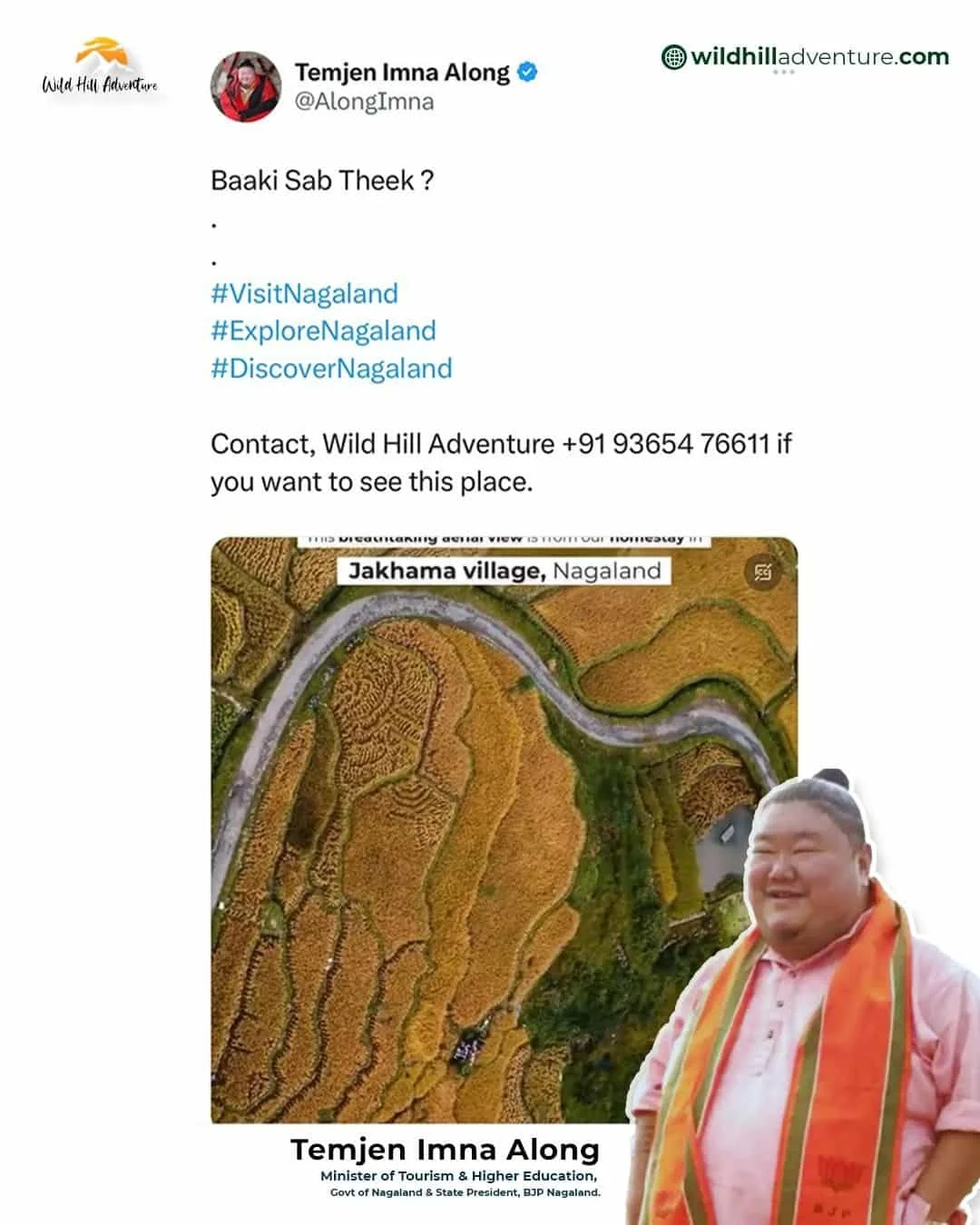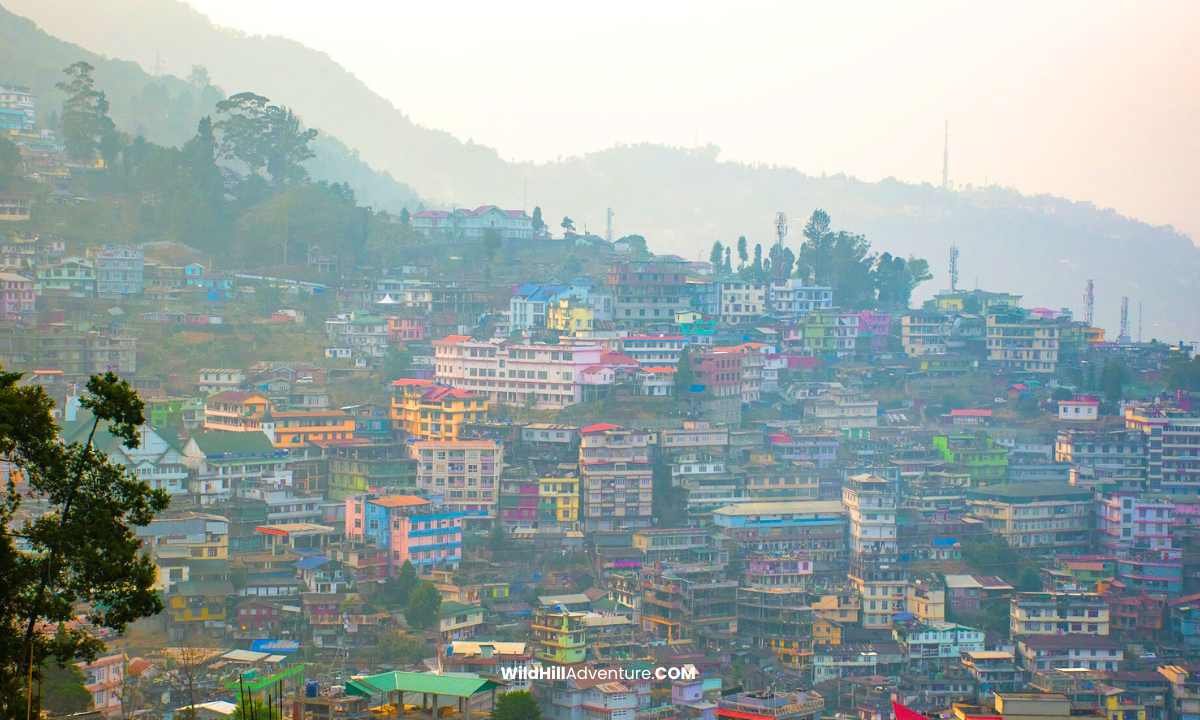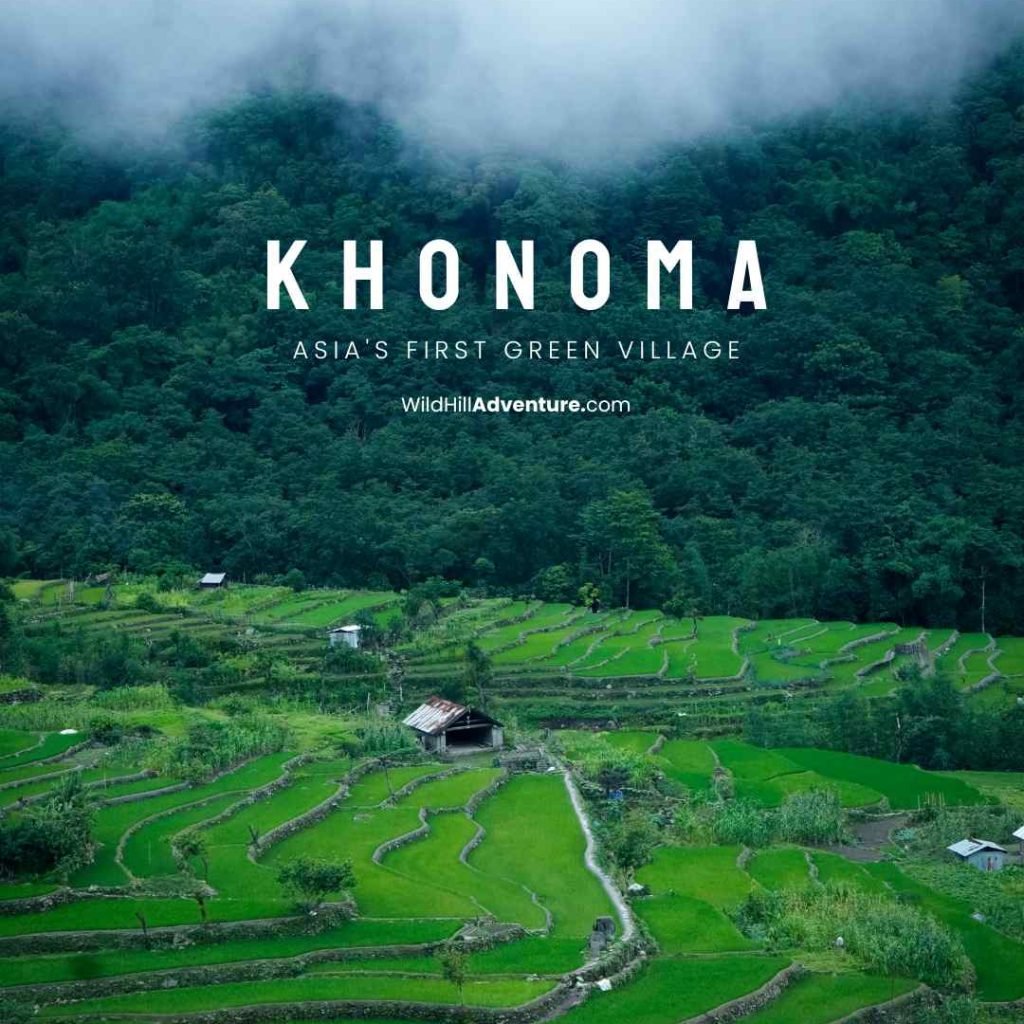4 Days 3 Nights
Specific Tour
16 people
___

Hornbill Festival with Khonoma and Dzuleke Tour Plan – A Complete 2025 Travel Guide
If you’re looking for a truly immersive cultural experience in India’s Northeast, the Hornbill Festival with Khonoma and Dzuleke Tour Plan is a journey you won’t forget. Set amidst the lush hills of Nagaland, this tour blends the electrifying energy of the Hornbill Festival with the tranquil charm of two of Nagaland’s most iconic villages: Khonoma and Dzuleke.
In this blog, we’ll guide you through a 4-day Hornbill Festival tour plan that covers everything—from vibrant tribal performances to sustainable village tourism. Let’s dive in!
Why Choose the Hornbill Festival with Khonoma and Dzuleke Tour?
Nagaland is one of India’s most culturally rich and unexplored regions. The Hornbill Festival, often called the “Festival of Festivals,” showcases the tribal diversity of the state. When combined with a visit to Khonoma, Asia’s first green village, and Dzuleke, a remote yet progressive community known for its unique trust-based economy, this tour becomes an unforgettable blend of culture, nature, and community.
Day-by-Day Hornbill Festival with Khonoma and Dzuleke Tour Plan (2025)
Day 1: Arrival at Dimapur – Transfer to Kohima

Your journey begins as you arrive at Dimapur Airport or Railway Station, where our representative will welcome you. Enjoy a scenic drive to Kohima, the capital of Nagaland. Depending on your arrival time, you may relax or explore the nearby local markets in the evening.
Overnight Stay: Kohima / Kisama / Jakhama
Day 2: Full Day at the Hornbill Festival
After breakfast, head to the Kisama Heritage Village for a full day at the Hornbill Festival. Watch traditional dance performances, listen to tribal music, try archery or indigenous games, and feast on local Naga delicacies.
What to Expect:
Pro Tip: Arrive early to get the best view of the performances and bring cash for food and souvenirs.
Overnight Stay: Kohima / Kisama / Jakhama
Day 3: Khonoma and Dzuleke Village Exploration

After breakfast, drive to Khonoma Village, known for its eco-conscious lifestyle and community-based forest conservation. Take a guided village walk to learn about Naga traditions, architecture, and agricultural practices.

Then proceed to Dzuleke, a hidden gem surrounded by dense forest and serene hills. Experience the unique local economy where shops have no shopkeepers—an inspiring model of honesty and trust. You can enjoy a short hike and interact with locals through a guided village tour.
Highlights:
Overnight Stay: Kohima / Kisama / Jakhama
Day 4: Departure
After breakfast, we will drop you off at Dimapur Airport or Railway Station for your return journey. Carry unforgettable memories of Nagaland and its beautiful people!
Inclusions in the Tour Plan
Exclusions
Accommodation Details
Standard Stay Options
Deluxe Stay Options
Note: All stays are subject to availability.
Note: Prices are valid for Indian tourists only. Minimum 4 persons required.
| Pax | Category | Vehicle | Per Person Price |
|---|---|---|---|
| 2 | Standard | Swift Dzire | ₹24,195 |
| 2 | Standard | Innova | ₹27,895 |
| 2 | Deluxe | Swift Dzire | ₹30,180 |
| 2 | Deluxe | Innova | ₹32,980 |
| Pax | Category | Vehicle | Per Person Price |
|---|---|---|---|
| 3 | Standard | Swift Dzire | ₹19,570 |
| 3 | Standard | Innova | ₹22,370 |
| 3 | Deluxe | Swift Dzire | ₹23,947 |
| 3 | Deluxe | Innova | ₹25,813 |
| Pax | Category | Vehicle | Per Person Price |
|---|---|---|---|
| 4 | Standard | Swift Dzire | ₹18,770 |
| 4 | Standard | Innova | ₹19,120 |
| 4 | Deluxe | Swift Dzire | ₹22,480 |
| 4 | Deluxe | Innova | ₹23,880 |
| Pax | Category | Vehicle | Per Person Price |
|---|---|---|---|
| 5 | Standard | Innova | ₹17,960 |
| 5 | Deluxe | Innova | ₹21,800 |
| Pax | Category | Vehicle | Per Person Price |
|---|---|---|---|
| 6 | Standard | Innova | ₹16,195 |
| 6 | Deluxe | Innova | ₹20,847 |
Best Time to Visit
The Hornbill Festival is held every year from December 1st to 10th in Kisama Heritage Village, near Kohima. To make the most of your experience, plan your tour in early December.
Tips for Travelers
Final Thoughts
The Hornbill Festival with Khonoma and Dzuleke Tour Plan is more than a vacation—it’s a cultural awakening. Whether you’re a cultural enthusiast, nature lover, or responsible traveler, this journey offers something special. From the energetic beats of tribal drums to the peaceful trails of Dzuleke, every moment is a discovery.
So, if you’re planning your Nagaland trip in 2025, don’t miss out on this once-in-a-lifetime adventure.
Ready to Plan Your Trip?
Let us help you customize the perfect itinerary. Contact us today for bookings, permits, and local guide arrangements.
Contact Wild Hill Adventure Directly!
1. What is the Hornbill Festival?
The Hornbill Festival is an annual cultural event held in Nagaland, India, celebrating the rich heritage of the state’s 17 major tribes. Known as the “Festival of Festivals,” it showcases traditional music, dance, crafts, cuisine, and sports, fostering unity and cultural preservation.
2. When and where is the Hornbill Festival held?
The festival takes place every year from December 1st to 10th at Kisama Heritage Village, located about 12 km from Kohima, the capital of Nagaland.
3. Why is it called the Hornbill Festival?
The festival is named after the Indian hornbill, a bird revered in Naga folklore for symbolizing bravery, beauty, and a deep connection with nature. It is often depicted in tribal art, dances, and traditions.
4. What are the main attractions of the Hornbill Festival?
Key highlights include:
Cultural Performances: Traditional dances, folk music, and war dances by Naga tribes.
Indigenous Games: Naga wrestling, archery, and bamboo pole climbing.
Naga Cuisine: Dishes like smoked pork, bamboo shoot curry, and rice beer (zutho).
Handicrafts: Handwoven textiles, jewelry, and wood carvings.
Hornbill International Rock Contest: A music competition featuring bands from India and abroad.
Night Bazaar: Vibrant stalls with food and souvenirs in Kohima.
5. How can I reach the Hornbill Festival?
By Air: The nearest airport is Dimapur Airport (73 km from Kohima), with flights from Delhi, Kolkata, and Guwahati. From Dimapur, take a taxi or shared cab to Kohima.
By Train: Dimapur Railway Station is the closest, connected to major cities like Guwahati. From there, travel to Kohima by taxi or bus.
By Road: Kohima is accessible via highways from neighboring states. Shared taxis or private cabs are available from Dimapur or other nearby cities.
6. Do I need a permit to attend the Hornbill Festival?
Indian Citizens: Require an Inner Line Permit (ILP), which can be obtained online at https://ilp.nagaland.gov.in or at the Deputy Resident Commissioner’s offices in Guwahati, Shillong, Delhi, or Kolkata.
Foreigners: Need a Protected Area Permit (PAP) and must register with the Foreigners’ Registration Office within 24 hours of entering Nagaland.
7. What is the best time to visit the Hornbill Festival?
The festival runs from December 1st to 10th, with peak festivities in the first week. The weather is pleasant (5°C to 15°C), but evenings can be chilly, so pack layers.
8. Where can I stay during the Hornbill Festival?
Options include:
Hotels in Kohima: Hotel Vivor, Hotel Japfu, or Razhu Pru for comfort.
Homestays: In Kisama or nearby villages like Kigwema for a cultural experience.
Campsites: Temporary tented camps near Kisama for budget travelers. Book early as accommodations fill up quickly.
9. Can tourists participate in the festival activities?
Yes, tourists are encouraged to engage with locals, taste Naga cuisine, and explore morungs (tribal huts). However, always ask for permission before participating in or photographing rituals.
10. What should I know before attending the Hornbill Festival?
Respect Local Customs: Seek permission before taking photos, especially during ceremonies, and dress modestly.
Connectivity: Mobile coverage is decent in Kohima, but internet at Kisama may be unreliable. Carry cash for transactions.
Weather: Expect cold temperatures, especially at night, so bring warm clothing.
Eco-Friendly Practices: Avoid littering and support local artisans by purchasing handicrafts directly.
11. What types of food are available at the festival?
Visitors can enjoy traditional Naga dishes like smoked pork, bamboo shoot curries, fermented soybean (axone), and spicy Bhut Jolokia chutneys. Rice beer (zutho) is a popular drink served in bamboo mugs.
12. Is the Hornbill Festival suitable for solo travelers?
Yes, the festival is safe for solo travelers, including solo female travelers. The event is well-organized, and locals are welcoming. However, exercise general caution, especially at night.
13. How many days are enough to experience the festival?
Spending 3 to 4 days allows you to enjoy cultural performances, visit morungs, and explore nearby attractions like Kohima’s night carnival or the World War II Museum.
14. What is the significance of morungs at the festival?
Morungs are traditional community huts where young Naga boys historically learned life skills, culture, and traditions. At the festival, each tribe sets up a morung to showcase their lifestyle, crafts, and food, offering visitors an immersive experience.
15. How does the Hornbill Festival contribute to cultural preservation?
The festival promotes Naga heritage by showcasing tribal traditions, fostering unity among tribes, and raising awareness about conservation issues, such as protecting the hornbill bird. It also supports local artisans and boosts tourism.
16. How can I book a tour for the Hornbill Festival?
For a hassle-free experience, book with a Northeast-based tour operator like Wild Hill Adventure. They offer tailored packages, such as the 6-day Kaziranga and Hornbill Festival Tour starting at ₹22,000, ensuring local expertise, authentic experiences, and seamless logistics. Contact them at +91 93654 76611 or wildhilladventure@gmail.com.
Your journey begins as you arrive at Dimapur Airport or Railway Station, where our representative will welcome you. Enjoy a scenic drive to Kohima, the capital of Nagaland. Depending on your arrival time, you may relax or explore the nearby local markets in the evening.
Overnight Stay: Kohima / Kisama / Jakhama
After breakfast, head to the Kisama Heritage Village for a full day at the Hornbill Festival. Watch traditional dance performances, listen to tribal music, try archery or indigenous games, and feast on local Naga delicacies.
What to Expect:
Pro Tip: Arrive early to get the best view of the performances and bring cash for food and souvenirs.
Overnight Stay: Kohima / Kisama / Jakhama
After breakfast, drive to Khonoma Village, known for its eco-conscious lifestyle and community-based forest conservation. Take a guided village walk to learn about Naga traditions, architecture, and agricultural practices.
Then proceed to Dzuleke, a hidden gem surrounded by dense forest and serene hills. Experience the unique local economy where shops have no shopkeepers—an inspiring model of honesty and trust. You can enjoy a short hike and interact with locals through a guided village tour.
Highlights:
Overnight Stay: Kohima / Kisama / Jakhama
After breakfast, we will drop you off at Dimapur Airport or Railway Station for your return journey. Carry unforgettable memories of Nagaland and its beautiful people!
The Hornbill Festival is a week-long cultural celebration held annually from December 1st to 10th in Kisama Heritage Village, near Kohima. It showcases the rich heritage, tribal traditions, dance, food, and crafts of all 17 major tribes of Nagaland.
The main venue is Kisama Heritage Village, located about 12 km from Kohima, the capital of Nagaland.
You can hire a taxi or take a shared vehicle from Dimapur (nearest railway station/airport) to Kohima and then proceed to Kisama Heritage Village.
The best time is between December 1st and 10th. However, arriving a day earlier helps you settle in and explore Kohima before the main events begin.
Yes, a nominal entry ticket is required, usually between ₹50–₹100,
Options include homestays in Kohima, Khonoma, and Dzuleke, or hotels in and around Kohima. Book well in advance as accommodation fills up fast.
Khonoma is India’s first Green Village, known for its eco-friendly practices, rich history, and Angami tribal culture. It’s also a model for community-based tourism in Nagaland.
Khonoma is around 20 km (1 hour) from Kohima by car.
Activities include:
Yes, traditional homestays are available and offer a local experience with delicious home-cooked meals.
Yes, it is considered very safe, and locals are friendly and welcoming.
Dzuleke is a remote and peaceful village near Khonoma, known for its pristine environment, zero plastic zone, and sustainable tourism.
It’s approximately 40 km (2–2.5 hours) from Kohima.
Yes, homestays run by the local community are available. They provide basic amenities, warm hospitality, and local food.
Kohima is the capital of Nagaland, known for its World War II Cemetery, Angami tribe culture, hilly landscapes, and being the gateway to the Hornbill Festival.
Local cuisine includes smoked pork, bamboo shoot dishes, rice beer, and vegetarian tribal meals.
Yes, pure vegetarian meals are available